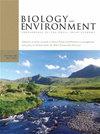POPULATION GENETICS AND CONSERVATION OF THE SMALL WHITE ORCHID, PSEUDORCHIS ALBIDA, IN IRELAND
IF 0.6
4区 环境科学与生态学
Q4 ENVIRONMENTAL SCIENCES
Biology and Environment-Proceedings of the Royal Irish Academy
Pub Date : 2022-01-01
DOI:10.3318/BIOE.2011.111.06
引用次数: 6
Abstract
Abstract:Genetic diversity can play a key role in the survival of endangered species. Both the number and size of populations of a species can affect genetic diversity and may be reduced by fragmentation of natural habitats. Here we examine the effects of a low number of populations and small population sizes on the population genetics of the nationally endangered and red-listed orchid Pseudorchis albida. To determine genetic variability within and among populations of P. albida, we employed AFLP and four plastid microsatellite (SSR) markers. In addition, we compared the SSR data from Irish P. albida to the closely related P. straminea. AFLP markers showed that P. albida has a high level of polymorphism and that significant differentiation occurred both within and among populations, with increasing population genetic isolation through distance. However, SSR markers revealed no variation, but did show that all Irish individuals had the same alleles as P. straminea rather than P. albida. Further work is required to assess the taxonomic status of P. albida/straminea in Western Europe. Irish populations of P. albida s.l. require immediate conservation attention due to their decreasing number and low numbers of individuals within populations.爱尔兰小白兰的种群遗传与保护
摘要:遗传多样性对濒危物种的生存起着关键作用。一个物种种群的数量和大小都能影响遗传多样性,并可能因自然栖息地的破碎化而减少。本文研究了低种群数量和小种群规模对国家濒危和列为红色名录的albida伪兰(Pseudorchis albida)种群遗传的影响。利用AFLP和4个质体微卫星(plas质体microsatellite, SSR)标记分析了紫花苜蓿居群内和居群间的遗传变异。此外,我们还将爱尔兰褐藻与亲缘关系较近的菌株P. straminea的SSR数据进行了比较。AFLP标记表明,紫花水杨具有较高的多态性,种群内和种群间均存在显著的分化,种群间的遗传隔离随着距离的增加而增加。然而,SSR标记没有发现变异,但确实表明所有爱尔兰个体具有与菌株P. straminea相同的等位基因,而不是P. albida。需要进一步的工作来评估在西欧albida/straminea的分类地位。爱尔兰褐藻种群数量不断减少,种群内个体数量较低,需要立即予以保护。
本文章由计算机程序翻译,如有差异,请以英文原文为准。
求助全文
约1分钟内获得全文
求助全文
来源期刊
CiteScore
1.10
自引率
0.00%
发文量
6
审稿时长
>36 weeks
期刊介绍:
The journal aims to offer a broad coverage of the subject area, including the following:
- biology and ecology of the Irish flora and fauna
- microbial ecology
- animal, plant and environmental physiology
- global change
- palaeoecology and palaeoclimatology
- population biology; conservation of genetic resources
- pollution and environmental quality; ecotoxicology
- environmental management
- hydrology
- land use, agriculture, soils and environment.
Submissions on other relevant topics are also welcome, and papers of a cross-disciplinary nature are particularly encouraged.

 求助内容:
求助内容: 应助结果提醒方式:
应助结果提醒方式:


